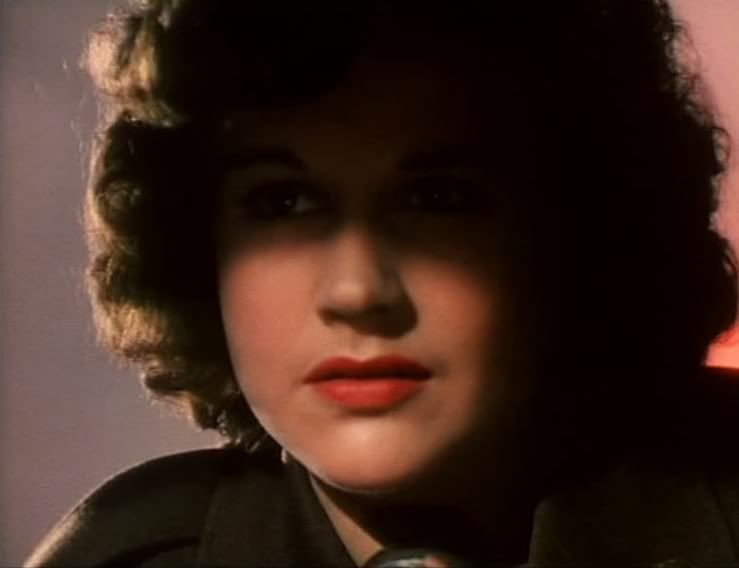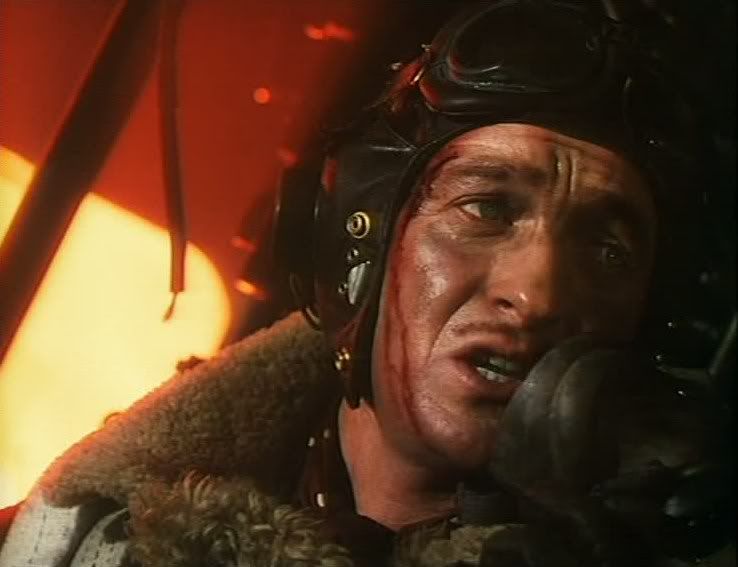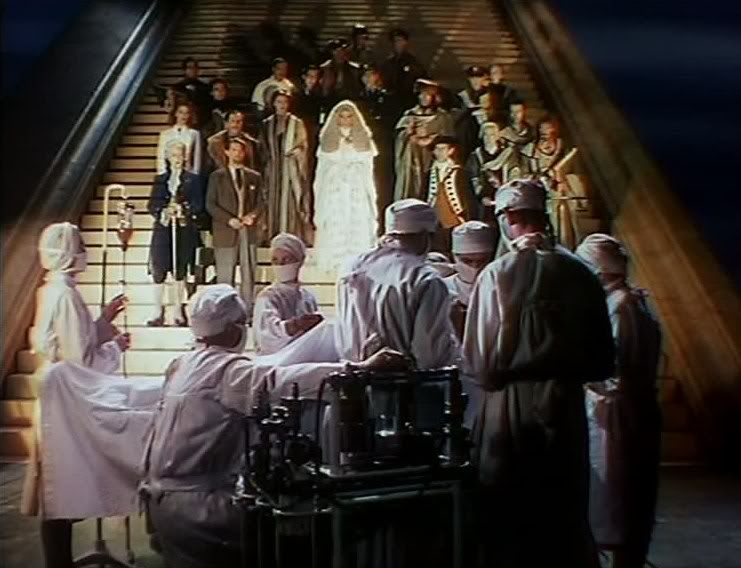

A Matter of Life and Death is an utterly charming fantasy of mortality and the afterlife, as well as a cross-Atlantic romance that considers the essence of Britishness as juxtaposed with and contrasted against the essence of Americanness. This collaboration between Michael Powell and Emeric Pressburger, the Archers, is a moving, inventive surrealist love story that, as the introductory voiceover announces, has its feet firmly in two worlds, poised between life and death. Set during World War II, the film concerns a mistake on the balance sheets of Heaven, involving the RAF pilot Peter Carter (David Niven), whose plane is destroyed and his parachute shredded, his crew ejecting at his orders, leaving him behind to bail out without a chute, seemingly to certain death.
The opening scenes, in which Peter shares his presumptive last words over the radio with the American dispatcher June (Kim Hunter), are remarkable and affecting, with Powell and Pressburger cutting back and forth between the faces of June and Peter as they bond in the final moments before the pilot bails out. June, bathed in shadows and red light, tries to keep from breaking up as she realizes what's happening, her voice thick with emotion. On the other end of the line, Peter's face is lit by the glow of the flames consuming his plane, his face black with grease, but his bravado unaffected, his face illuminated by a charming grin. Their words fly back and forth in a rapid patter, Peter displaying an unflappable grace under pressure, a willingness to go his death with a smile on his face and a few flirtatious words going out over the wire to the American girl. This scene sets the tone for the whole picture, establishing a cavalier, flippant attitude towards the end, a stiff-upper-lip bravery that doesn't allow for any tears, any sadness, not from Peter at least, who prepares for his presumably fatal leap without the least bit of sentiment. Those moodily lit, sensuous closeups connect these two people at a crucial moment, and the unforgettable effect of this scene lingers over the entirety of the film.
Peter makes his leap into the choppy ocean below, but as it turns out, he doesn't die: the heavenly conductor (Marius Goring) meant to usher him into the afterlife loses him in the thick British fog, and Peter washes up on shore, briefly believing that he's actually dead, that he's woken up on a heavenly shore. Instead, he's washed up near the country house where June is staying, and they meet for the first time, instantly falling in love, their emotions primed by their deeply affecting radio contact. This creates something of a problem when the conductor finally tracks Peter down, since now Peter, who had been prepared to go to his death with a quip and a smile just hours before, has something to tie him to Earth, something to live for. Peter, suffering from headaches and other signs of a concussion, struggles in two worlds, facing an appeal for his life in a heavenly court as well as preparing for a brain operation under the worldly care of Dr. Frank Reeves (Roger Livesey).

The film alternates between these two worlds, with the earthly scenes shot in sumptuous, brightly colored Technicolor and the surreal heavenly scenes in stark, plain black-and-white, which has the effect of rendering the real world vivid and sensuous, while Heaven has a no-nonsense logic to its management of souls — there's even a massive data center, managed by angelic clerks, with files on the living and the dead. Jack Cardiff's cinematography is gorgeous throughout, and the transitions between realms are handled with slow fades, color slowing returning to the world of the living as Peter funnels from life into the land of the dead and then back again. The imagery consistently reflects the ideas of two worlds that can interact. Dr. Reeves even has a camera obscura, a glowing oval in the darkness that he pans across the village as though watching a movie, gazing down from a heavenly perspective, providing a running commentary on everything he sees. When he opens his doors to let June in, the oval goes blank and a yellow light is cast over the room; light, as always in Powell and Pressburger's films, is used like paint.
At the crux of the film is the "special relationship" between America and Britain, one-time enemies who had become allies, an alliance particularly tested during the war that had just ended when this film was released. Powell and Pressburger don't miss an opportunity to tweak the cultural connections and differences between the two countries, as in the scene where a group of American servicemen with thick New York accents act out Shakespeare's A Midsummer's Night Dream, getting into their parts despite the accent disconnect. Peter's trial becomes a British versus American conflict, as his prosecutor is Abraham Farlan (Raymond Massey), the first American killed by the British during the American revolution. Hilariously, Farlan holds up a sleepy-sounding British cricket announcer as evidence of British cultural bankruptcy, while Reeves, acting as Peter's defense, counters with American jazz to demonstrate how out-of-touch Farlan is with what's currently happening in the world, and to show that the two countries are simply speaking different languages, culturally speaking, though they're unified in other ways. Reeves chooses a jury made up entirely of Americans, which turns out to be embodied as a series of stereotypes, demonstrating the melting pot of American culture. And the push/pull nature of American/British relations is encapsulated in the small touches too, like the way that, after Reeves cites the possibility of a British serviceman falling in love with an American girl, an American GI in the audience looks over at the rows of British nurses nearby and wistfully adds, "or vice versa." The film pokes fun at various cultural stereotypes — the lugubriousness of the British radio announcer, the gangster-type mannerisms of the Americans reciting Shakespeare, the series of multicultural clichés on the jury — in order to suggest that cultural differences and historical grievances can be set aside, both for the sake of true love, and on a larger scale in forming new national alliances that draw together countries that had started out being at odds with one another.
This is an utterly charming, whimsical film that's also infused with the complex emotions of a romance that's on the verge of being torn apart from the moment it begins. The film's melancholy, sumptuous beauty is perhaps best embodied in the poetic image of one of June's tears, preserved as a ripe dew-drop on the petal of a flower as prospective evidence in Peter's heavenly trial. Powell and Pressburger expertly weave this kind of sentiment together with the film's occasionally goofy comedic sensibility and the fantasy aesthetic of the Heaven sequences. The result is a bittersweet comedy with an overriding feeling of impending loss balancing its charm and its humor.
Lovely summary of this unique film. I think there's something very deeply moving, about this film that often gets overlooked in the discussion of the British-American relationship which dominates its ending, which is simply this: that at the time people had been fighting or had lost family members who were in the forces, and what they were fighting for was this one, not their place in the next. And although the dead souls are very chipper, Heaven with its regimentation and clerks, is clearly not a patch on the ramshackle, dangerous but beautiful and spontaneous temporal world. I can't think of a more simple, beautiful way of expressing the enormity of sacrifice and loss going on at the time. It's never stated explicitly since there was no need, but just part of the very fabric of the film, our most immediate perception of it, how it hits our retinas.
ReplyDelete"They are starved for Technicolor up there!"
ReplyDeleteNice write-up Ed, and you rightly note that there is some whimsical humor here, that can become somewhat absent in their later works....Black Narcissus and The Red Shoes etc. This IS a great love story. There are portions of love stories in the other films, but they don't feel as central in the others, outside of I Know Where I'm Going!. That initial scene is a knockout and vies with the best scenes they ever created. Not sure the film always maintains that heightened state, but it is one wild and inventive little film. Actually now that I think of it, Wings of Desire owes a little bit to this film.
ReplyDelete"This scene sets the tone for the whole picture, establishing a cavalier, flippant attitude towards the end, a stiff-upper-lip bravery that doesn't allow for any tears, any sadness, not from Peter at least, who prepares for his presumably fatal leap without the least bit of sentiment. Those moodily lit, sensuous closeups connect these two people at a crucial moment, and the unforgettable effect of this scene lingers over the entirety of the film."
ReplyDeleteFavorite part of the review. The sensual, lush Technicolor and urgent close-ups make their banter feel more passionate than most movie embraces. I wonder how Niven felt about the scene, considering he not only served in the War but married his first wife after a whirlwind two-week romance.
"A Matter of Life and Death is an utterly charming fantasy of mortality and the afterlife, as well as a cross-Atlantic romance that considers the essence of Britishness as juxtaposed with and contrasted against the essence of Americanness."
ReplyDeleteYour opening sentence says quite a bit in capsulizing it, but as always you go well beyond in an exhilarating essay of one of the most justly celebrated of the Archers' film, a movie that would rank high on any fantasy listing. The film will be showing the second week of November on the 70 foot screen of the Jersey City Loews' movie palace, and I'll be there with bells on!
Extraordinary essay Ed!